Photovoltaic-STATCOM with Low Voltage Ride through Strategy and Power Quality Enhancement in a Grid Integrated Wind-PV System
Abstract
1. Introduction
2. Voltage Sag Mitigation
2.1. LVRT Requirements in the Grid Codes
2.2. VSC-Based PV-STATCOM
3. Control Strategy for PV-STATCOM
3.1. Grid Voltages and Currents
3.2. Real and Reactive Power Control
4. Result and Discussion
5. Conclusions
Acknowledgments
Author Contributions
Conflicts of Interest
References
- Manish, P.; Prabir, R.K. Voltage Sag Mitigation by D-STATCOM Using Voltage Regulation Technique. Int. J. Eng. Res. Technol. 2014, 3, 1–7. [Google Scholar]
- Ismail, N.; Wan Abdullah, W.N. Enhancement of Power Quality in Distribution System Using D-Statcom. In Proceedings of the 4th International Power Engineering and Optimization Conference (PEOCO2010), Shah Alam, Malaysia, 23–24 June 2010. [Google Scholar]
- Singh, S.; Rai, V.; Kumar, A.; Sahay, K.B. Simulation and comparison of DVR and D-STATCOM for voltage sag mitigation. In Proceedings of the 2016 IEEE 6th International Conference on Power Systems (ICPS), New Delhi, India, 4–6 March 2016; pp. 1–6. [Google Scholar]
- Dugan, R.C. Electrical Power Systems Quality, 2nd ed.; Professional Engineering; McGraw-Hill Companies: New York, NY, USA, 2004; pp. 1–525. [Google Scholar]
- Mariun, N.; Masdi, H.; Bashi, S.M.; Mohamed, A.; Yusuf, S. Design of a Prototype D-STATCOM Using DSP Controller for Voltage Sag Mitigation. In Proceedings of the 2006 IEEE Power India Conference, New Delhi, India, 10–12 April 2006; pp. 1–6. [Google Scholar]
- Obando-Montaño, A.F.; Carrillo, C.; Cidrás, J.; Díaz-Dorado, E. A STATCOM with Supercapacitors for Low-Voltage Ride-Through in Fixed-Speed Wind Turbines. Energies 2014, 7, 5922–5952. [Google Scholar] [CrossRef]
- Yanan, L.; Lijun, T. Research on Low Voltage Ride through Technology of Grid-Connected Photovoltaic System. In Proceedings of the International Conference on Smart Grid and Clean Energy Technologies, Chengdu, China, 19–22 October 2016. [Google Scholar]
- Zhang, M.G.; Chen, X.J. A control strategy of low voltage ride through for grid-connected photovoltaic power system. Power Syst. Prot. Control 2014, 42, 28–33. [Google Scholar]
- Hsu, C.-W.; Lee, C.-T.; Cheng, P.-T. A Low-Voltage Ride-Through Technique for Grid-Connected Converters of Distributed Energy Resources. IEEE Trans. Ind. Appl. 2011, 47, 1821–1832. [Google Scholar]
- Yang, Y.; Blaabjerg, F.; Wang, H. Low Voltage Ride-Through of Single-Phase Transformerless Photovoltaic Inverters. IEEE Trans. Ind. Appl. 2014, 50, 1942–1952. [Google Scholar] [CrossRef]
- Yang, Y.; Wang, H.; Blaabjerg, F. Reactive Power Injection Strategies for Single-Phase Photovoltaic Systems Considering Grid Requirements. IEEE Trans. Ind. Appl. 2014, 50, 4065–4076. [Google Scholar] [CrossRef]
- Gabashm, A.; Li, P. On Variable Reverse Power Flow-Part I: Active-Reactive Optimal Power Flow with Reactive Power of Wind Stations. Energies 2016, 9, 1–12. [Google Scholar]
- Ghorbanian, M.J.; Goodarzvand, F. Mitigating Voltage Sag by Implementing STATCOM onDFIG-based Wind Farms Connected to a Power System. In Proceedings of the 4th International Conference on Engineering Technology and Technopreneuship (ICE2T), Kuala Lumpur, Malaysia, 27–29 August 2014. [Google Scholar]
- Castilla, M.; Miret, J.; Camacho, A.; Matas, J.; de Vicuña, L.J. Voltage Support Control Strategies for Static Synchronous Compensators under Unbalanced Voltage Sags. IEEE Trans. Ind. Electron. 2014, 61, 456–467. [Google Scholar] [CrossRef]
- Liang, H.F.; Feng, Y.C.; Liu, Z.X.; Gao, Y.J.; Wang, C.S. Research on low voltage ride through of photovoltaic plant based on deadbeat control. Power Syst. Prot. Control 2013, 41, 110–115. [Google Scholar]
- Gabash, A.; Li, P. Active-reactive optimal power flow for low-voltage networks with photovoltaic distributed generation. In Proceedings of the 2nd IEEE Energy Conference, Florence, Italy, 9–12 September 2012; pp. 381–386. [Google Scholar]
- Masdi, H.; Mariun, N.; Mahmud, S.; Mohamcd, A.; Yusuf, S. Design of a Prototype D-Statcom for Voltage Sag Mitigation. In Proceedings of the Kuala Lumpur Malaysia 61National Power & Gncrgy Coiiferctlcc (1′ECon), Kuala Lumpur, Malaysia, 29–30 November 2004. [Google Scholar]
- Naik, L.; Palanisamy, K. A Dual Operation of PV-Statcom as Active Power Filter and Active Power Injector in Grid Tie Wind-PV System. Int. J. Renew. Energy Res. 2015, 5, 1–5. [Google Scholar]
- Singh, B.; Saha, R.; Chandra, A.; Al-Haddad, K. Static synchronous compensators (STATCOM): A review. IET Power Electron. 2009, 2, 297–324. [Google Scholar] [CrossRef]
- Arnold, G. Challenges of Integrating Multi-GW Solar Power Into the German Distribution Grids. In Proceedings of the 17th Power System Computation Conference PSCC, Stockholm, Sweden, 22–26 August 2011. [Google Scholar]
- Yang, Y.; Blaabjerg, F.; Wang, H.; Simoes, M. Power control flexibilities for grid-connected multifunctional photovoltaic inverters. In Proceedings of the 4th International Workshop on Integration of Solar Power into Power Systems, Berlin, Germany, 10–11 November 2014; Energynautics GmbH: Darmstadt, Germany, 2014; pp. 233–239. [Google Scholar]
- Liu, Y.Y.; Zeng, C.B.; Miao, H.; Fu, W.W. Research on a New Method to Achieve Low Voltage Ride through of PV. In Proceedings of the 2014 International Conference on Power System Technology (POWERCON), Chengdu, China, 20–22 October 2014; pp. 1628–1634. [Google Scholar]
- Teodorescu, R.; Liserre, M.; Rodriguez, P. Grid Converters for Photovoltaic and Wind Power System; Wiley: Hoboken, NJ, USA, 2011. [Google Scholar]
- Naderipour, A.; Zin, A.A.M.; Habibuddin, M.H.; Mortadi, M.; Miveh, M.; Afrouzi, H.N. A New Compensation Control Strategy for Grid-Connected Wind Turbine and Fuel Cell Inverters in a Microgrid. Int. J. Power Electron. Drive Syst. 2017, 8, 272–278. [Google Scholar] [CrossRef]
- Akagi, H.; Watanabe, E.H.; Arede, M. Instantaneous Power Theory and Applications to Power Conditioning; John Wiley & Sons: Hoboken, NJ, USA, 2007; Volume 31. [Google Scholar]
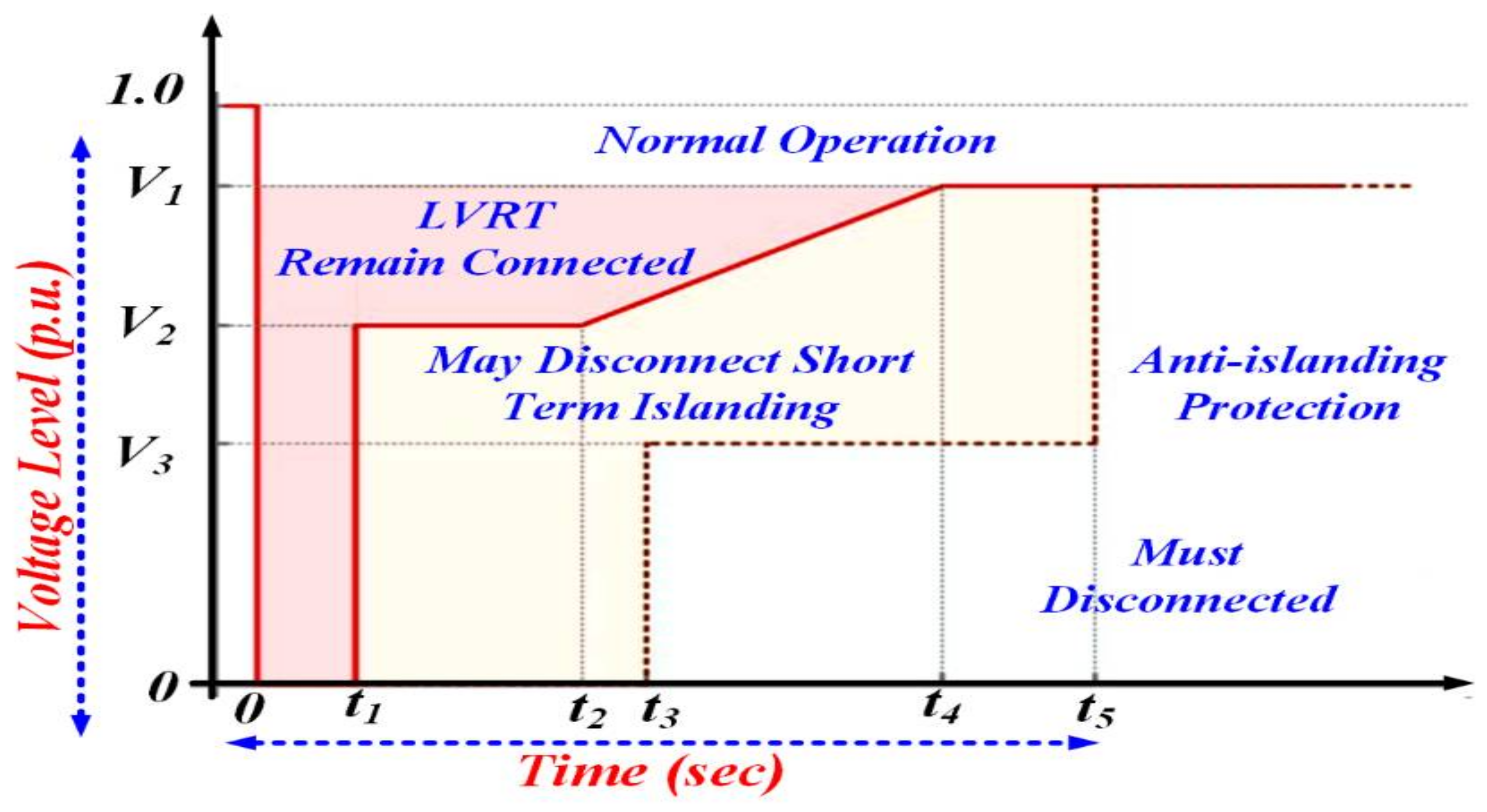

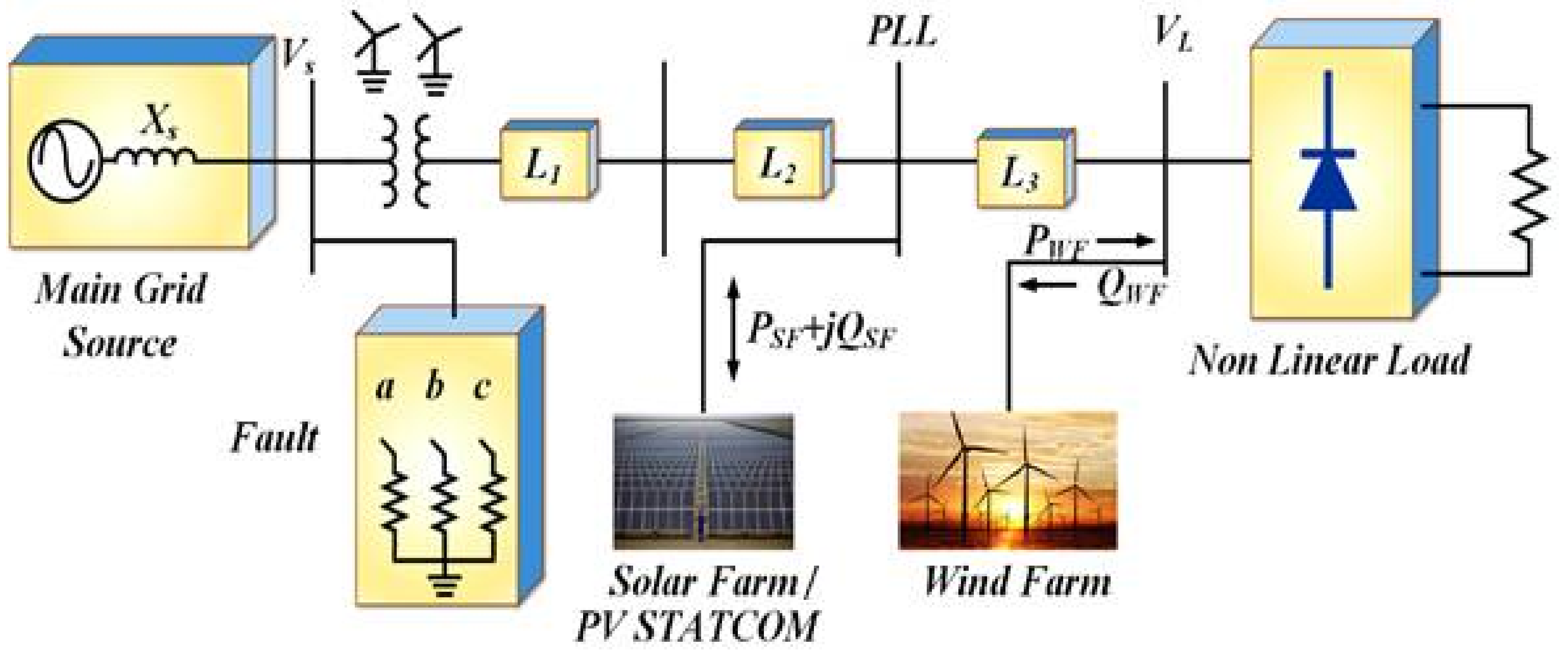
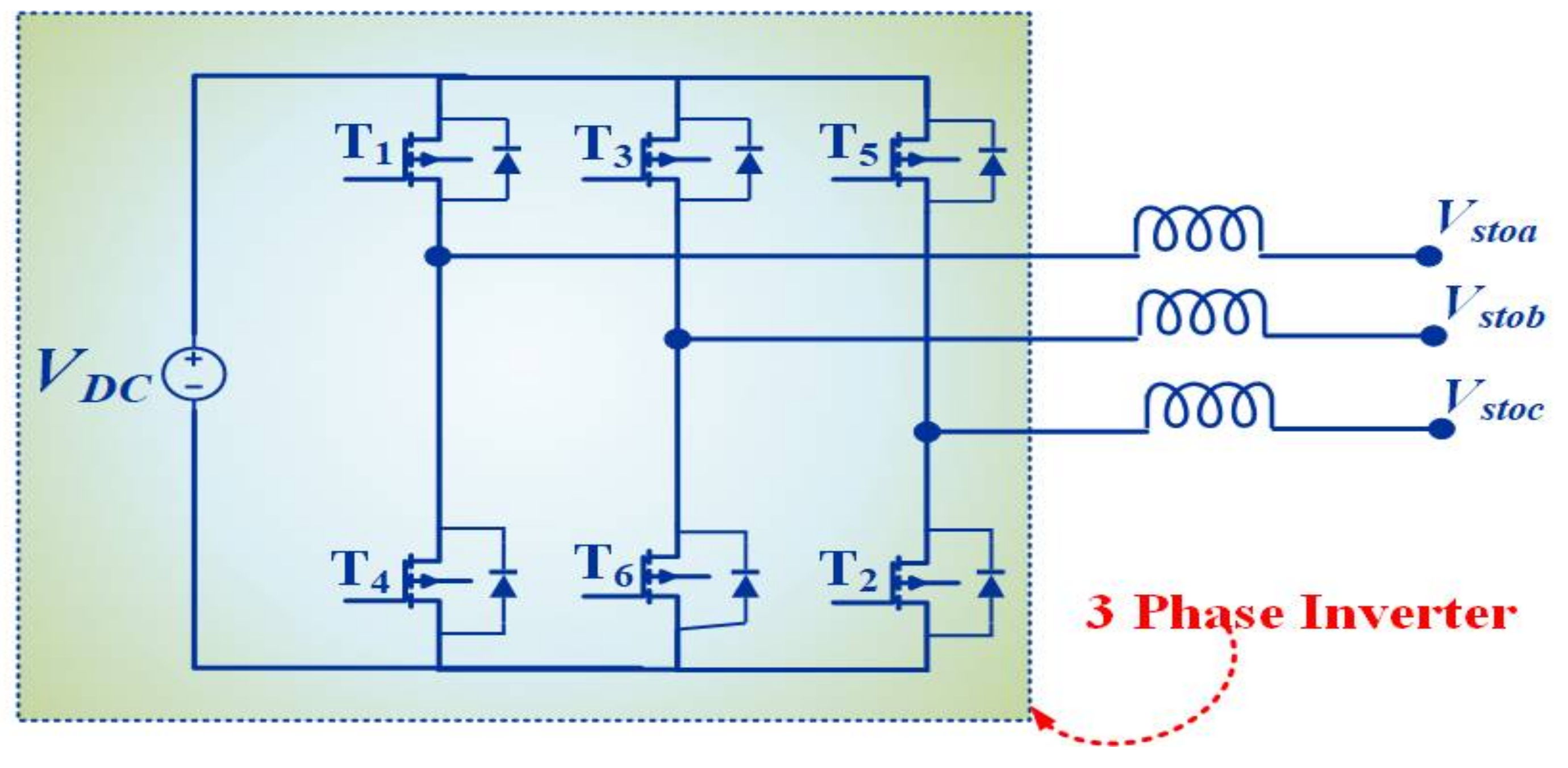
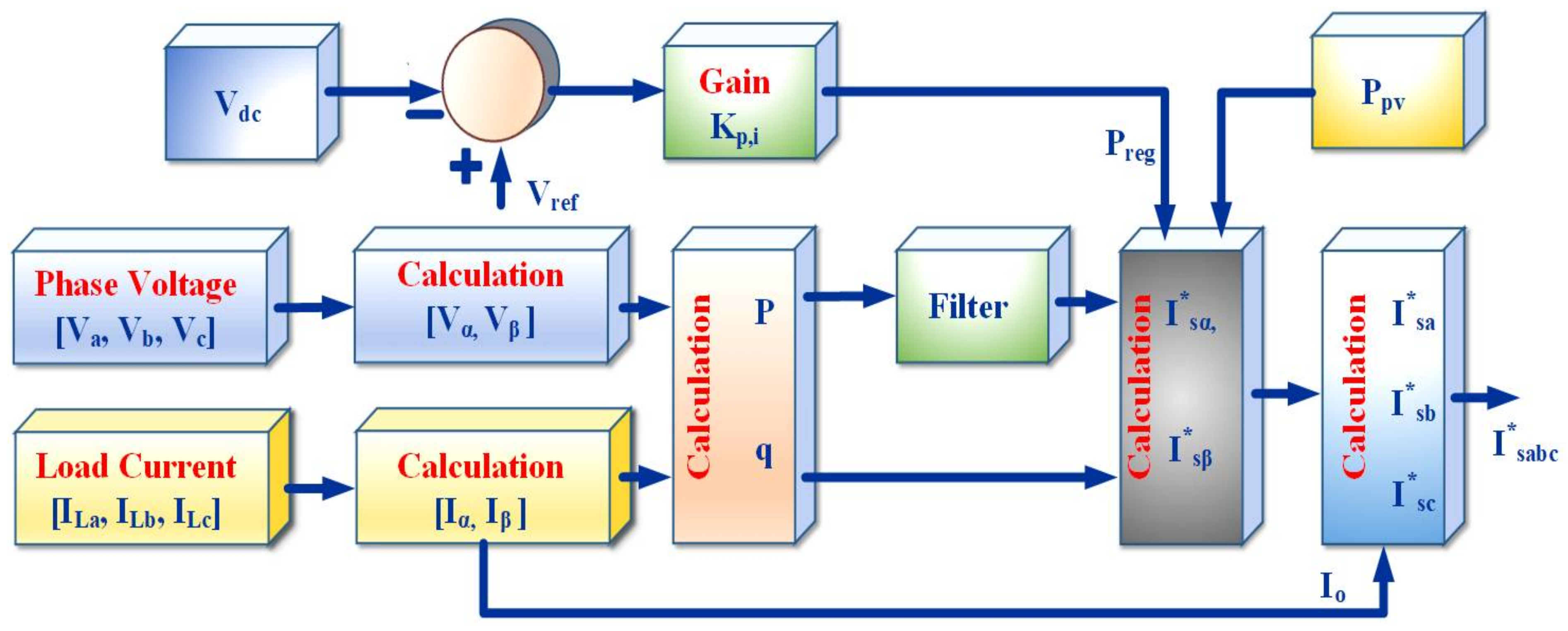

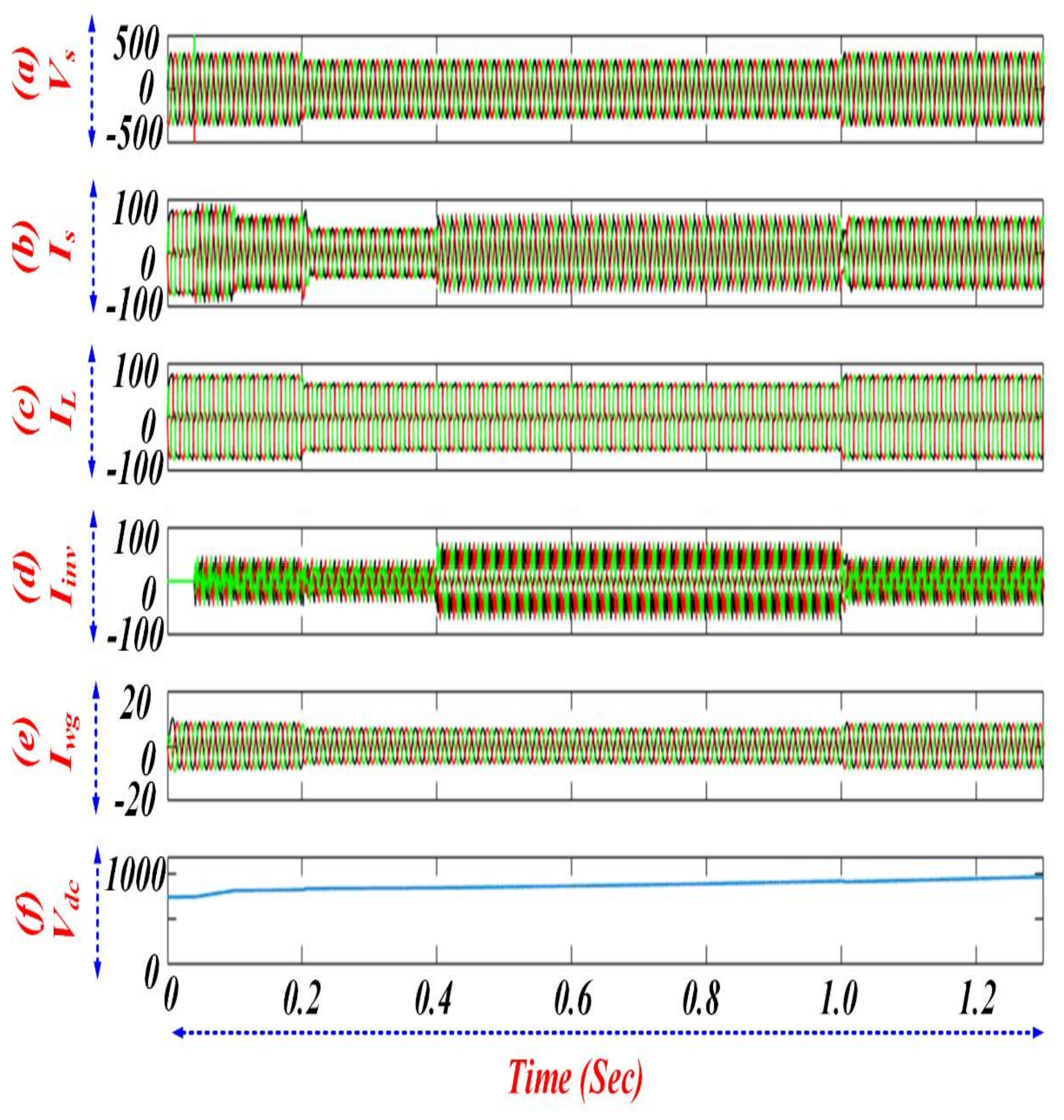

| S. No | Parameter | Specifications |
|---|---|---|
| 1 | Source Voltage | 415 V, 50 Hz |
| 2 | Line Parameters | R = 0.1 Ω, Lr = 0.05 m H |
| 3 | Solar Plant | 10 kVA |
| 4 | Wind Generator | 3.30 kVA, 415 V, 50 Hz, N = 1500 rpm, P = 4, Rr = 20 Ω, Lr = 0.06 H |
| 5 | DC Bus Capacitor | Vdc = 750 V, Cdc = 10 mF |
| 6 | Interfacing Inductor (Lf) | Lf = 1.75 mH |
| 7 | Distorting Load | 8 Ω, 8 mH |
© 2018 by the authors. Licensee MDPI, Basel, Switzerland. This article is an open access article distributed under the terms and conditions of the Creative Commons Attribution (CC BY) license (http://creativecommons.org/licenses/by/4.0/).
Share and Cite
Popavath, L.N.; Kaliannan, P. Photovoltaic-STATCOM with Low Voltage Ride through Strategy and Power Quality Enhancement in a Grid Integrated Wind-PV System. Electronics 2018, 7, 51. https://doi.org/10.3390/electronics7040051
Popavath LN, Kaliannan P. Photovoltaic-STATCOM with Low Voltage Ride through Strategy and Power Quality Enhancement in a Grid Integrated Wind-PV System. Electronics. 2018; 7(4):51. https://doi.org/10.3390/electronics7040051
Chicago/Turabian StylePopavath, Lakshman Naik, and Palanisamy Kaliannan. 2018. "Photovoltaic-STATCOM with Low Voltage Ride through Strategy and Power Quality Enhancement in a Grid Integrated Wind-PV System" Electronics 7, no. 4: 51. https://doi.org/10.3390/electronics7040051
APA StylePopavath, L. N., & Kaliannan, P. (2018). Photovoltaic-STATCOM with Low Voltage Ride through Strategy and Power Quality Enhancement in a Grid Integrated Wind-PV System. Electronics, 7(4), 51. https://doi.org/10.3390/electronics7040051




